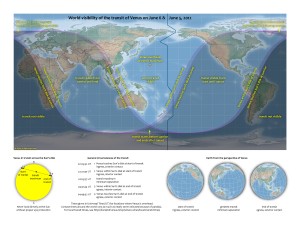Next Tuesday/Wednesday (depending on your location on Earth), you may have the opportunity to witness the transit of Venus, or a view of the planet against the backdrop of the Sun. Once every century or so, Venus passes between Earth and the Sun, presenting itself as a moving black spot. Actually, transits happen twice every century or so. Every 105.5 or 121.5 years, Venus passes between us and the Sun; eight years later, it passes by again. But after that second pass, we need to wait another 105.5 or 121.5 years. The last transit was in 2004, so if you miss this one, you’re out of luck in this lifetime.
In theory, viewing a transit is easy. It takes hours—typically around six—for Venus to complete the crossing. But ideal viewing requires ideal positioning: if you’re on the Pacific Rim, you may be able to follow the entire transit; if you’re in North America, you’ll only see the beginning of it; in Europe, west and south Asia, Africa, or western Australia, you’ll see only the end of it. Check with your local astronomy club or observatory to see if they’ve planned any special viewing events (more on that at the end of this post).
Eye protection: again, easy in theory. Those eclipse shades or #14 welding glass you bought for viewing the recent solar eclipse will work for this, too, as long as you have better eyesight than I do. I’m not likely to see Venus with the naked eye. This means I need to use the appropriate solar filters and projectors on my telescope, or go find someone else with this equipment, since going blind is not on my agenda this summer. For some safety advice and a list of helpful equipment suggestions, visit transitofvenus.org.
We’ll be heading down to Lake Monroe next Tuesday to take advantage of the equipment and knowledge of the Indiana University Astronomy Club and Stonebelt Stargazers. See Visit Bloomington for a short description of the event. The DNR has a flyer (.pdf) available for download as well. Activities for children run from 1:30-5:00 p.m. EDT next Tuesday, June 5, at Paynetown SRA (Lake Monroe). Short videos about the transit will be playing from 3-5:00 p.m. EDT. Transit viewing will be from 6-8:00 p.m. EDT.
If you’re reading this from the University of Illinois, you should make plans to head over to Parkland College next Tuesday. The UIUC Astronomical Society and the Champaign Urbana Astronomical Society will be setting up west of Parkland’s Staerkel Planetarium around 4:30 p.m. Transit begins at 5:09 p.m. CDT and they will make sure you are viewing it in a safe manner.
If you’re north of Bloomington, Indiana and Champaign-Urbana, Illinois (that is, in the Michiana region), check out Midwest Treasure: Trove (download flyer here). There are at least five public viewing sites set up in the South Bend/Dunes area of Indiana. Good times!
Finally, I’ve linked to a NASA video above to give you some background on the transit, but space.com has a nice write up on the (early Modern) history of human response to the event.
ETA: Visit NASA’s Transit of Venus Event Locations to find a viewing spot near you!
